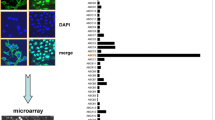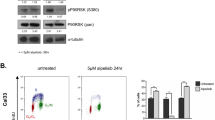Abstract
Purpose
Acquired multidrug resistance (MDR) has been linked to overexpression of drug-metabolising and transporting proteins mediated by pregnane-x-receptor (PXR). The aim of this work was to establish the relevance of PXR for MDR in head and neck squamous cell carcinoma (HNSCC).
Methods
Using eight HNSCC cell lines, we determined the efficacy of paclitaxel, cisplatin and 5-fluorouracil (5-FU) via proliferation assays and determined the expression and activity of PXR through quantitative real-time polymerase chain reaction, western blotting and luciferase-based reporter gene assay. PXR knockdown approaches using shRNA-encoding vectors were applied to estimate the role of PXR for native MDR.
Results
Drug resistance ranged between 5.2 and 620 nM for paclitaxel, varied between 4.5 and 58 μM for cisplatin, and varied between 1.1 and 5,467 μM for 5-FU. Lack of PXR mRNA expression was mostly accompanied by the absence of mRNA expression of cytochrome P450 3A4 (CYP3A4) and P-glycoprotein (P-gp, ABCB1) expression. Neither mRNA nor protein expression of PXR correlated with drug resistance. However, PXR activity tended to correlate with IC50 values of paclitaxel (p = 0.08). Knockdown of PXR in one of the cell lines had a slight but not significant impact on paclitaxel efficacy compared to scrambled sequence control. Surprisingly, only in two cell lines, PXR activity was increased by the well-known inductor rifampicin.
Conclusion
This study suggests a malfunctioning of PXR and thus a minor relevance for iatrogenic chemotherapy resistance in HNSCC.




Similar content being viewed by others
References
Fanucchi M, Khuri FR (2004) Chemotherapy for recurrent or metastatic squamous cell carcinoma of the head and neck. Semin Oncol 31:809–815
Gottesman MM, Fojo T, Bates SE (2002) Multidrug resistance in cancer: role of ATP-dependent transporters. Nat Rev Cancer 2:48–58
Theile D, Ketabi-Kiyanvash N, Herold-Mende C, Dyckhoff G, Efferth T, Bertholet V et al (2011) Evaluation of drug transporters’ significance for multidrug resistance in head and neck squamous cell carcinoma. Head Neck 33:959–968
Blumberg B, Sabbagh W Jr, Juguilon H, Bolado J Jr, van Meter CM, Ong ES et al (1998) SXR, a novel steroid and xenobiotic-sensing nuclear receptor. Genes Dev 12:3195–3205
Synold TW, Dussault I, Forman BM (2001) The orphan nuclear receptor SXR coordinately regulates drug metabolism and efflux. Nat Med 7:584–590
Beijnen JH, Schellens JH (2004) Drug interactions in oncology. Lancet Oncol 5:489–496
Desai PB, Nallani SC, Sane RS, Moore LB, Goodwin BJ, Buckley DJ et al (2002) Induction of cytochrome P450 3A4 in primary human hepatocytes and activation of the human pregnane X receptor by tamoxifen and 4-hydroxytamoxifen. Drug Metab Dispos 30:608–612
Huang R, Murry DJ, Kolwankar D, Hall SD, Foster DR (2006) Vincristine transcriptional regulation of efflux drug transporters in carcinoma cell lines. Biochem Pharmacol 71:1695–1704
Masuyama H, Hiramatsu Y, Kodama J, Kudo T (2003) Expression and potential roles of pregnane X receptor in endometrial cancer. J Clin Endocrinol Metab 88:4446–4454
Conde I, Lobo MV, Zamora J, Pérez J, González FJ, Alba E et al (2008) Human pregnane X receptor is expressed in breast carcinomas, potential heterodimers formation between hPXR and RXR-alpha. BMC Cancer 8:174–188
Takeyama D, Miki Y, Fujishima F, Suzuki T, Akahira J, Hata S (2010) Steroid and xenobiotic receptor in human esophageal squamous cell carcinoma: a potent prognostic factor. Cancer Sci 101:543–549
Rioja J, Bandrés E, Rosell Costa D, Rincón A, López I, Zudaire Bergera JJ et al (2011) Association of steroid and xenobiotic receptor (SXR) and multidrug resistance 1 (MDR1) gene expression with survival among patients with invasive bladder carcinoma. BJU Int 107:1833–1838
Ninck S, Reisser C, Dyckhoff G, Helmke B, Bauer H, Herold-Mende C (2003) Expression profiles of angiogenic growth factors in squamous cell carcinomas of the head and neck. Int J Cancer 106:34–44
Freier K, Hofele C, Gross M, Devens F, Dyckhoff G, Plinkert P et al (2010) Cytogenetic characterization of head and neck squamous cell carcinoma cell lines as model systems for the functional analyses of tumor-associated genes. J Oral Pathol Med 39:382–389
Peters T, Lindenmaier H, Haefeli WE, Weiss J (2006) Interaction of the mitotic kinesin Eg5 inhibitor monastrol with P-glycoprotein. Naunyn Schmiedebergs Arch Pharmacol 372:291–299
Patel RD, Hollingshead BD, Omiecinski CJ, Perdew GH (2007) Aryl-hydrocarbon receptor activation regulates constitutive androstane receptor levels in murine and human liver. Hepatology 46:209–218
Theile D, Grebhardt S, Haefeli WE, Weiss J (2009) Involvement of drug transporters in the synergistic action of FOLFOX combination chemotherapy. Biochem Pharmacol 78:1366–1373
König SK, Herzog M, Theile D, Zembruski N, Haefeli WE, Weiss J (2010) Impact of drug transporters on cellular resistance towards saquinavir and darunavir. J Antimicrob Chemother 65:2319–2328
Albermann N, Schmitz-Winnenthal FH, Z’graggen K, Volk C, Hoffmann MM, Haefeli WE et al (2005) Expression of the drug transporters MDR1/ABCB1, MRP1/ABCC1, MRP2/ABCC2, BCRP/ABCG2, and PXR in peripheral blood mononuclear cells and their relationship with the expression in intestine and liver. Biochem Pharmacol 70:949–958
Jones SA, Moore LB, Shenk JL, Wisely GB, Hamilton GA, McKee DD et al (2000) The pregnane X receptor: a promiscuous xenobiotic receptor that has diverged during evolution. Mol Endocrinol 14:27–39
Cerveny L, Svecova L, Anzenbacherova E, Vrzal R, Staud F, Dvorak Z et al (2007) Valproic acid induces CYP3A4 and MDR1 gene expression by activation of constitutive androstane receptor and pregnane X receptor pathways. Drug Metab Dispos 35:1032–1041
Gu X, Ke S, Liu D, Sheng T, Thomas PE, Rabson AB et al (2006) Role of NF-kappaB in regulation of PXR-mediated gene expression: a mechanism for the suppression of cytochrome P-450 3A4 by proinflammatory agents. J Biol Chem 281:17882–17889
Weiss J, Theile D, Spalwisz A, Burhenne J, Riedel KD, Haefeli WE (2013) Influence of sildenafil and tadalafil on the enzyme- and transporter-inducing effects of bosentan and ambrisentan in LS180 cells. Biochem Pharmacol (in press)
Masuyama H, Nakatsukasa H, Takamoto N, Hiramatsu Y (2007) Down-regulation of pregnane X receptor contributes to cell growth inhibition and apoptosis by anticancer agents in endometrial cancer cells. Mol Pharmacol 72:1045–1053
Scotto KW (2003) Transcriptional regulation of ABC drug transporters. Oncogene 22:7496–7511
Costea DE, Tsinkalovsky O, Vintermyr OK, Johannessen AC, Mackenzie IC (2006) Cancer stem cells—new and potentially important targets for the therapy of oral squamous cell carcinoma. Oral Dis 12:443–454
Diaz LA Jr, Williams RT, Wu J, Kinde I, Hecht JR, Berlin J et al (2012) The molecular evolution of acquired resistance to targeted EGFR blockade in colorectal cancers. Nature 486:537–540
Blagosklonny MV (2002) STI-571 must select for drug-resistant cells but ‘no cell breathes fire out of its nostrils like a dragon’. Leukemia 16:570–572
Zuo C, Zhang H, Spencer HJ, Vural E, Suen JY, Schichman SA et al (2009) Increased microsatellite instability and epigenetic inactivation of the hMLH1 gene in head and neck squamous cell carcinoma. Otolaryngol Head Neck Surg 141:484–490
Bennett KL, Romigh T, Eng C (2009) AP-2alpha induces epigenetic silencing of tumor suppressive genes and microsatellite instability in head and neck squamous cell carcinoma. PLoS ONE 4:6931
Mensah-Osman EJ, Thomas DG, Tabb MM, Larios JM, Hughes DP, Giordano TJ et al (2007) Expression levels and activation of a PXR variant are directly related to drug resistance in osteosarcoma cell lines. Cancer 109:957–965
Takagi S, Nakajima M, Mohri T, Yokoi T (2008) Post-transcriptional regulation of human pregnane X receptor by micro-RNA affects the expression of cytochrome P450 3A4. J Biol Chem 283:9674–9680
Wang H, Venkatesh M, Li H, Goetz R, Mukherjee S, Biswas A et al (2011) Pregnane X receptor activation induces FGF19-dependent tumor aggressiveness in humans and mice. J Clin Invest 121:3220–3232
Piedade R, Schaeffeler E, Winter S, Asimus S, Schwab M, Ashton M et al (2012) PXR variants and artemisinin use in Vietnamese subjects: frequency distribution and impact on the interindividual variability of CYP3A induction by artemisinin. Antimicrob Agents Chemother 56:2153–2157
Lichti-Kaiser K, Xu C, Staudinger JL (2009) Cyclic AMP-dependent protein kinase signaling modulates pregnane x receptor activity in a species-specific manner. J Biol Chem 284:6639–6649
Acknowledgments
Parts of the project were funded by Grants #107173 and #107204 from the German Cancer Aid. Juan Pablo Rigalli was supported by a grant from the German Academic Exchange Service. The authors thank Corina Mueller for excellent technical assistance.
Conflict of interest
None.
Author information
Authors and Affiliations
Corresponding author
Rights and permissions
About this article
Cite this article
Rigalli, J.P., Reuter, T., Herold-Mende, C. et al. Minor role of pregnane-x-receptor for acquired multidrug resistance in head and neck squamous cell carcinoma in vitro. Cancer Chemother Pharmacol 71, 1335–1343 (2013). https://doi.org/10.1007/s00280-013-2133-x
Received:
Accepted:
Published:
Issue Date:
DOI: https://doi.org/10.1007/s00280-013-2133-x




